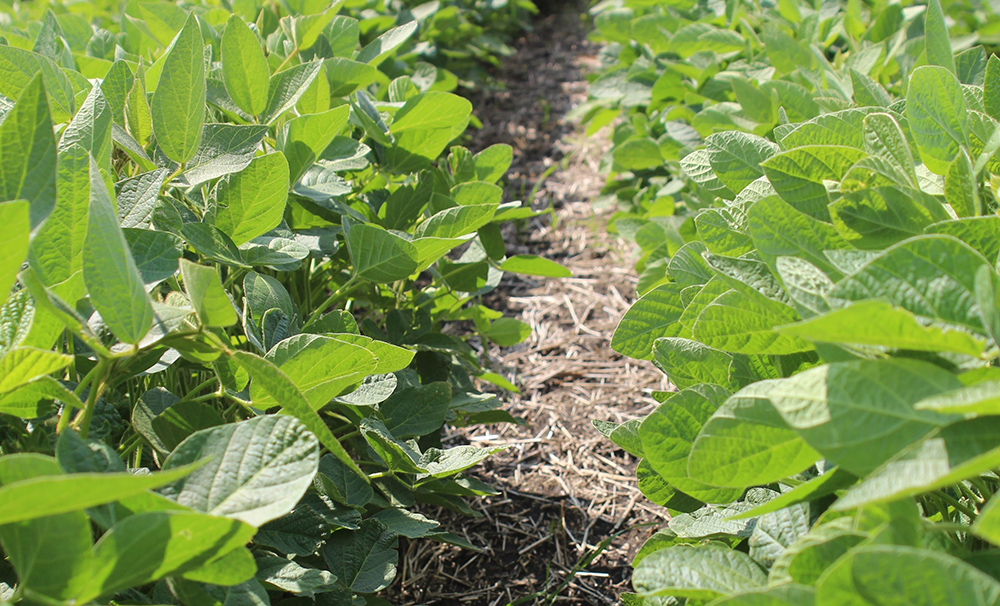Weather has hindered production in recent years, but farmers still see potential and are eager to return to the crop
Despite cratered production in Western Canada, soybean boosters are bullish about its prospects on the Prairies.
Beneath the dark clouds of years of drought and 2022’s saturated spring, the crop is getting tougher and easier to grow and promises to be more profitable than ever.
“It’s actually hardier and comes out of the ground faster and has all those (improved) characteristics,” said eastern Manitoba grower Melvin Rattai about his hopes for this year’s late-seeded soybeans.
“It just takes off.”
Around his table at Soy Canada’s annual meeting June 20 in Winnipeg, people were guessing that Manitoba growers would seed about one million acres of the crop. That’s a big drop from earlier hopes for 1.5 million acres, which is itself part of a protracted slump from 2017’s 2.3 million acres, and a far cry from the hopes of some that the crop could soon hit three million acres in the province.
Read Also

VIDEO: Claas Axion 9.450 tractor wins ‘Tractor of the Year’ at Agritechnica 2025
On opening day of Agritechnica 2025, Claas’ Axion 9.450 Terra Trac tractor was awarded ‘Tractor of the Year’ for 2026 in the HighPower category.
However, Rattai said farmers had their fields prepped for soybeans, so if it was physically possible to plant beans, farmers did.
“It’s not that they cut it out. They cut it back, so there’s less acres seeded just because of the timing,” said Rattai.
Farmers were still seeding a few acres June 20, although most farmers wouldn’t dare touch a seeding date that late.
However, with earlier-maturing varieties becoming available, farmers are now able to stick with soybeans when that wouldn’t have happened 10 years ago.
Saskatchewan farmers have also dropped acres this spring, for the same reasons as Manitoba farmers. In 2017, they grew 850,000 acres, but last year seeded just about 85,000. This year that could drop to 50,000.
But Creelman producer Winston Van Staveren said farmers are keen to get back to growing more of the crop.
“In the long term, I see them going up,” said Van Staveren.
“I think there’s good potential in the genetics.”
That’s the silver bullet that could slay many of the acreage limiters that now bedevil prairie soybeans, the industry believes. For years, breeders, faced with cool, wet growing seasons focused on developing short-season soybeans. Part of that has been developing varieties that don’t suffer as much from iron chlorosis in saturated springs.
But with the recent spate of droughts, breeders have been working on drought-resistant varieties that can handle the opposite problem too. And production problems like phytophthora are being tackled as well.
Altogether, prairie-developed varieties are creating a stronger crop.
“All those things are coming along,” said Jeff Loessin, head of Canadian seed for Corteva Agriscience.
“They’re being moved from… later season soybeans into the earlier season soybeans.”
Genetics are also seen as the key resource for cracking the low-protein problem prairie soybeans often suffer. Overseas buyers and feed formulators don’t like low-protein soybeans unless they can get it at a hefty discount, which cuts the price to farmers. Breeders are working on the issue, hoping for better growing conditions to reveal how close they are to solving it.
Soybeans might have struggled with short seasons until now, but Rattai said new varieties requiring 2,400 heat units (HU) are letting farmers relax.
“By the middle of September, they’re actually ripe,” he said, noting that 2,200 HU varieties are being developed.
For Brian Innes, the executive director of Soy Canada, soybeans have a bright future, especially as the Prairies heat up. Some predict that farmers will have 500 more HU per growing season, which will greatly benefit soybeans if sufficient precipitation comes.
“That makes a huge difference,” said Innes.
“500 heat units now allows you to grow a 00 soybean in a place where you maybe had only a 30 percent chance of success.”
In 2016, Soy Canada set a goal of doubling Canadian soybean production. Ontario production has stayed strong and Quebec production has grown, allowing the region to be near its 2027 target already.
However, Western Canada’s problems leave the goals far from being met. Acres now, at 1.4 million, are beneath the level already reached by 2016, and less than 25 percent of the six million targeted.
Yields were more than 40 bushels per acre in 2016 but dropped to less than 27 in 2021.
If 2022 experiences better growing conditions, regardless of the late spring, some of the new genetic potential could reveal itself and help restore some of the lost excitement.
Reaching those 2027 goals won’t seem like such a long shot if yields jump this year and farmers put a bigger acreage into the crop next year.
“We’re marching towards (the 2027 targets),” said Innes.
“Whether we march quickly enough to get there by 2027 is still a question, but there is continued optimism.”
















